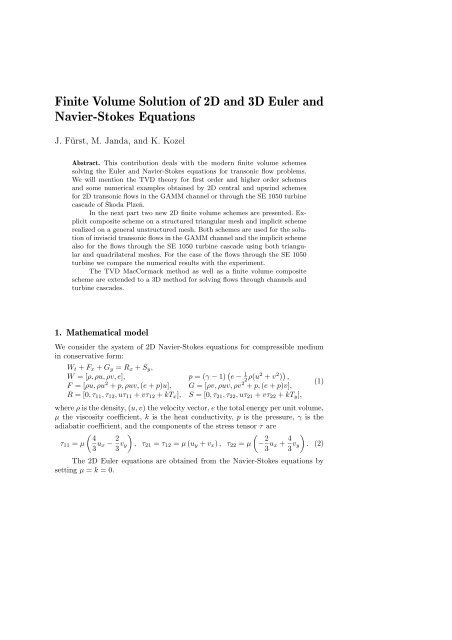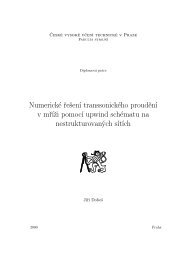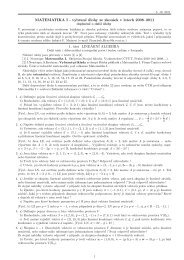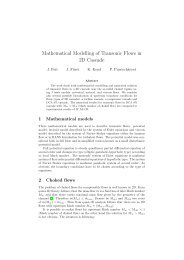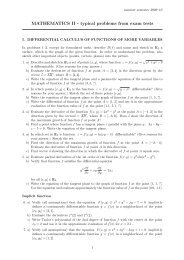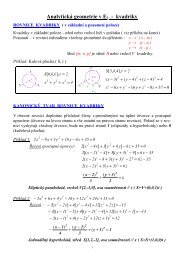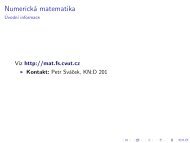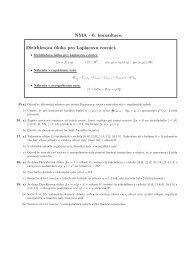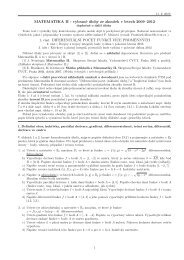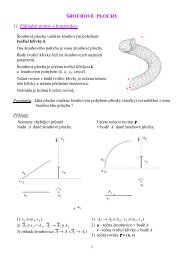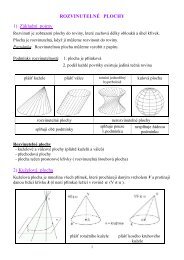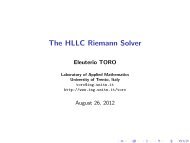Finite Volume Solution of 2D and 3D Euler and Navier-Stokes ...
Finite Volume Solution of 2D and 3D Euler and Navier-Stokes ...
Finite Volume Solution of 2D and 3D Euler and Navier-Stokes ...
You also want an ePaper? Increase the reach of your titles
YUMPU automatically turns print PDFs into web optimized ePapers that Google loves.
176 J. Fürst, M. J<strong>and</strong>a, <strong>and</strong> K. KozelLet us consider a general one-dimensional method <strong>of</strong> the formu n+1i = u n i − C i− 12 (un i − u n i−1) + D i+ 12 (un i+1 − u n i ), (9)then the following theorem <strong>of</strong> Harten [15] can be used to check the TVD property.Lemma 2.2 (Harten,1983). Let the following conditions be fulfilled ∀i ∈ Z:C i− 1 ≥ 0, D 2 i+ 1 ≥ 0, C 2 i+ 1 + D 2 i+ 1 ≤ 1. (10)2Then the numerical method (9) is TVD.This lemma gives some hints how to correct some classical high order methodsin order to be TVD. Unfortunately, this lemma is valid only for the one-dimensionalcase. In fact, Goodman <strong>and</strong> LeVeque show in [12], that the TVD property in themultidimensional case implies only a first order accuracy.In spite <strong>of</strong> their result, many methods based on one-dimensional high orderTVD methods have been constructed for practical multidimensional problems.Although they are not TVD, they remain high order for smooth solutions <strong>and</strong>usually do not generate oscillations near discontinuities.For practical computations we use the MacCormack predictor-corrector schemebecause <strong>of</strong> its simple implementation especially for nonlinear systems. The TVDMacCormack scheme has for one-dimensional scalar problem the following form:with G ± defined by<strong>and</strong>u n+ 1 2i = u n i − ∆t (f(un∆x i ) − f(u n i−1) ) , (11)u n+1i = 1 [u n i + u n+ 1 2i − ∆t (f(u n+ 1 2i+12∆x) − 1 f(un+ 2i )) ] , (12)u n+1i = u n+1i + [ G + (r + i ) + G− (r − i+1 )] (u n i+1 − u n i ) −− [ G + (r + i−1 ) + G− (r − i )] (u n i − u n i−1) (13)G ± (r ± i ) = |f ′ (u n i )|∆t2∆x2.2. Extension to the <strong>2D</strong> scalar case(1 − |f ′ (u n i )|∆t ) [ 1 − Φ(r ± i∆x)] (14)Φ(r ± i ) = max ( 0, min(2r ± i , 1)) . (15)The scalar initial value problem for the <strong>2D</strong> problem is given by the equationu t + f(u) x + g(u) y = 0 with the initial condition u(x, y, 0) = u 0 (x, y). We againsolve this problem in the unbounded domain (x, y, t) ∈ R × R × R + .For a two-dimensional scalar case we analyzed in [9] a class <strong>of</strong> monotoneschemes (especially the so called l 1 -contractive schemes) <strong>and</strong> published in [11] thefollowing lemma:
178 J. Fürst, M. J<strong>and</strong>a, <strong>and</strong> K. Kozel<strong>and</strong> for each k ≠ 0 (we set ˜f k = 0 <strong>and</strong> ˜f k = 0 for k < −p <strong>and</strong> k > q)˜f k (u n i−p,j, ..., v n i+q,j) ≤ ˜f k+1 (u n i−p−1,j, ..., v n i+q−1,j), (23)˜g k (u n i,j−p, ..., v n i,j+q) ≤ ˜g k+1 (u n i,j−p−1, ..., v n i,j+q−1) (24)then the schemeu n+1i,j = u n i,j − ∆t (˜fn∆xi+ 1 2 ,j − ˜f)ni− 1 2 ,j − ∆t ()˜g n∆yi,j+− ˜g n 12 i,j−, (25)12˜f n i+ 1 2 ,j = ˜f(u n i−p,j, u n i−p+1,j, ..., u n i+q,j), ˜g n i,j+= ˜g(u n i,j−p, u n i,j−p+1, ..., u n i,j+q)12is monotone (<strong>and</strong> hence TVD).Unfortunately it is not possible to construct a high order TVD scheme formultidimensional problem [12]. The uniform TVD bound is too restrictive <strong>and</strong>therefore one should consider following approach analyzed for example by Coquel<strong>and</strong> LeFloch in [4, 3]. Let us assume a two-dimensional conservative scheme <strong>of</strong> theform:u n+1i,j= u n i,j − ∆t (˜fn∆xi+ 1 2 ,j − ˜f)ni− 1 2 ,j − ∆t ()˜g n∆yi,j+− ˜g n 12 i,j−, (26)12with ∆x = ∆y = const.∆t <strong>and</strong> consistent with the equation u t +f(u) x +g(u) y = 0.Theorem 2.5 (Coquel, LeFloch 1991). Let the numerical fluxes f n i+ 1 2 ,j <strong>and</strong> gn i,j+ 1 2can be split onto two parts f n i+ 1 2 ,j = pn ∆x+i+ 1 2 ,j ∆t an i+ 1 2 ,j <strong>and</strong> gn = q n +i,j+ 1 2 i,j+ 1 2with p <strong>and</strong> q being monotone fluxes (e.g. first order Lax-Friedrichs type)∆y∆t bn i,j+ 1 2<strong>and</strong> a <strong>and</strong> b being antidiffusive high order corrections. If there exist for a finitetime T > 0 constants C > 0 <strong>and</strong> M > 0 independent <strong>of</strong> ∆t (<strong>and</strong> consequentlyindependent <strong>of</strong> ∆x <strong>and</strong> ∆y) such that||u n i,j|| ∞ < C, |a n i+ 1 ,j| < M∆xα , |b n2 i,j+| < M∆y α , (27)12with n∆t < T <strong>and</strong> α ∈ ( 2 3, 1), then the piecewise constant function with the valuesgiven by u n i,j converges to the unique entropy solution when ∆t → 0.Example 2.6 (<strong>2D</strong> version <strong>of</strong> the scheme proposed by Davis). Let us suppose the <strong>2D</strong>scheme for the two-dimensional linear equation proposed by Davis u t +cu x +du y =0 :u n+1i,j = u n i,j − c ∆t2∆x (un i+1,j − u n i−1,j) + c 2 ∆t22∆x 2 (un i+1,j − 2u n i,j + u n i−1,j) ++ K(r + i,j , r− i+1,j )(un i+1,j − u n i,j) − K(r + i−1,j , r− i,j )(un i,j − u n i−1,j) − (28)−d ∆t2∆y (un i,j+1 − u n i,j−1) + d 2 ∆t22∆y 2 (un i,j+1 − 2u n i,j + u n i,j−1) ++ K(s + i,j , s− i,j+1 )(un i,j+1 − u n i,j) − K(s + i,j−1 , s− i,j )(un i,j − u n i,j−1) (29)
180 J. Fürst, M. J<strong>and</strong>a, <strong>and</strong> K. Kozelwhich is a set <strong>of</strong> m independent scalar problems. For each component we can usethe TVD MacCormack scheme defined in the previous section. In order to get theTVD MacCormack scheme for the original variables W , we multiply the schemewritten for the characteristic variables V by the matrix R. Finally, we getW n+ 1 2i = Wi n − ∆t (AWn∆x i − AWi−1n ), (44)W n+1i = 1 [Wi n + W n+ 1 2i − ∆t () ]AW n+ 1 2i+1 − AW n+ 1 2i , (45)2∆x[W n+1i = W n+1i + R ˜G+ (˜r + i ) + ˜G]− (˜r − i+1 ) R −1 (Wi+1 n − Wi n ) −[−R ˜G+ (˜r + i−1 ) + ˜G]− (˜r − i ) R −1 (Wi n − Wi−1). n (46)Here ˜r ± iare vectors with m components(˜r + i )(l) = ( R −1 (W n i − W n i−1) ) (l)/(R −1 (W n i+1 − W n i ) ) (l), (47)(˜r − i )(l) = ( R −1 (W n i+1 − W n i ) ) (l)/(R −1 (W n i − W n i−1) ) (l), (48)where r (l) denotes the l-th component <strong>of</strong> the vector r.The viscosity coefficients ˜G are m × m diagonal matrices with the elementsgiven by˜G ± (˜r ± i )(l,l) = 1 |a (l) |∆t2 ∆x(1 − |a(l) |∆t∆x )[1 − Φ((˜r± i )(l) )]. (49)In order to avoid the evaluation <strong>of</strong> eigenvectors <strong>of</strong> the Jacobian matrix A weuse the so called simplified TVD scheme proposed by D. M. Causon in [2] whichis for the case <strong>of</strong> the one-dimensional nonlinear system written as:W n+ 1 2i = Wi n − ∆t (F (Wn∆x i ) − F (Wi−1) n ) , (50)W n+1i = 1 [Wi n + W n+ 1 2i − ∆t (F (W n+ 1 2i+12∆x) − F (W n+ 1 2i )) ] , (51)]W n+1i = W n+1i +[G + (r + i ) + G− (r − i+1 ) (Wi+1 n − Wi n ) −]−[G + (r + i−1 ) + G− (r − i ) (Wi n − Wi−1) n (52)with G ± <strong>and</strong> r ± given by the formulasr + i = , r− i = ,G ± (r ± i ) = 1 2 C(ν i) [ {1 − Φ(r ± i )] νi (1 − ν, C(ν i ) =i ), ν i ≤ 0.50.25, ν i > 0.5,∆tν i = ρ Ai ∆x . (53)Here < ., . > denotes the st<strong>and</strong>ard inner (scalar) product in R m <strong>and</strong> ρ Ai is thespectral radius <strong>of</strong> the Jacobi matrix ∂F/∂W at the point W i (for the case <strong>of</strong> the
182 J. Fürst, M. J<strong>and</strong>a, <strong>and</strong> K. KozelFor the two-step LW scheme one has:W n+1/2i = 1 33∑Wk n − ∆t 3∑(F2µk,i∆y n k − G n k,i∆x k ), (63)ik=1W n+1i = Wi n − ∆t 3∑µ ik=1(F n+1/2k,ik=1∆y k − G n+1/2k,i∆x k ). (64)The cell-vertex corresponding to the one-dimensional staggered version hasthe following form (assuming for simplicity that six triangles meet at each vertex):LF:W ∗ i = 1 3W n+10,k= 1 63∑W0,k n − ∆t 3∑(2µ ˜F k ∆y k − ˜G k ∆x k ), (65)ik=1k=1˜F k = 1 2 (F 0,k+1 − F 0,k ), ˜Gk = 1 2 (G 0,k+1 − G 0,k ),6∑Wi ∗ − ∆t 6∑(2µ ˜F i ∗ ∆y i − ˜G ∗ i ∆x y ), (66)0,ki=1i=1˜F ∗ i = 1 2 (F ∗ i+1 − F ∗ i ), ˜G∗ i = 1 2 (G∗ i+1 − G ∗ i ).LW scheme uses the same first step as the above described LF scheme <strong>and</strong> thesecond step is <strong>of</strong> the form:W n+10,k= W0,k n − ∆t 6∑(2µ ˜F i ∗ ∆y i − ˜G ∗ i ∆x y ). (67)0,kHere W 0,k are located at the vertices V 0,k <strong>of</strong> the triangle T i <strong>and</strong> Wi∗ are locatedat the centers <strong>of</strong> gravity P i <strong>of</strong> triangles T i .The composite scheme consists again as N − 1 steps <strong>of</strong> LW scheme followedby one LF step. The value <strong>of</strong> N is determined by numerical testing. The cell vertexscheme was also extended to three-dimensional case.Remark: Composite schemes were introduced by R. Liska <strong>and</strong> B. Wendr<strong>of</strong>f fora <strong>2D</strong> nonlinear hyperbolic problem solved by finite difference methods on an orthogonalgrid. The idea is following: in many high order schemes one has to addsome artificial viscosity terms in order to achieve solution without oscillations nearshock waves or steep gradients. Composite schemes use certain number <strong>of</strong> a highorder scheme (with low value <strong>of</strong> artificial viscosity) <strong>and</strong> the arising oscillations arethen smeared by one step <strong>of</strong> a more dissipative scheme (for example Lax-Friedrichsscheme).We extended the original finite difference schemes to <strong>2D</strong> <strong>and</strong> <strong>3D</strong> finite volumemethod <strong>of</strong> the cell centered or cell vertex form [14].i=1
<strong>Solution</strong> <strong>of</strong> <strong>2D</strong> <strong>and</strong> <strong>3D</strong> <strong>Euler</strong> <strong>and</strong> <strong>Navier</strong>-<strong>Stokes</strong> Equations 1834. Implicit finite volume method for <strong>2D</strong> inviscid flowsThe numerical solution is again obtained by the finite volume approach: The domainΩ is approximated by a polygonal domain Ω h <strong>and</strong> this polygonal domain isdivided into m polygonal convex cells 3 C i possess the following property:m⋃Ω h = C i <strong>and</strong> C i ∩ C j = ∅ for i ≠ j .i=1Figure 1 shows a sample <strong>of</strong> such adomain divided into 13 triangular, quadrilateral,<strong>and</strong> pentagonal cells. Let m i denotethe number <strong>of</strong> cells adjacent to C i (i.e.number <strong>of</strong> cells that share an edge with thecell C i ) <strong>and</strong> let the set N i = {i 1 , i 2 , ..., i mi }contain their indices (see Fig. 1 where m i =5). Next, let us denote by Biinlet the set <strong>of</strong>edges shared by the cell C i <strong>and</strong> the inletboundary Γ inleth<strong>of</strong> Ω h ; similarly for Bioutleti 3Si 3SSii 4 i 24ii 5 S i 1Si1i 5Figure 1. Unstructured gridwith mixed type <strong>of</strong> cells.<strong>and</strong> B walli .The basic finite volume scheme is obtainedin the usual way: integrating the conservation law in a cell C i , applyingGreen’s theorem <strong>and</strong> approximating the integral over the boundary <strong>of</strong> C i by thenumerical flux functions. The scheme is thenW n+1i = W n i − ∆tR 1 (W n ) i . (68)Here Win st<strong>and</strong>s for the approximation <strong>of</strong> the solution in the cell C i at a timet = n∆t <strong>and</strong> R 1 (W n ) i is the component <strong>of</strong> the residual vector computed as⎡⎤R 1 (W n ) i = 1 ⎣ ∑H(Wi n , Wj n , Sµ(C i )⃗ i,j ) + ∑ ∑H b (Wi n , S ⃗ e ) ⎦ . (69)j∈N i bThe superscript 1 denotes the first order approximation, µ(C i ) is the volume <strong>of</strong>the cell C i , ⃗ S i,j denotes the outer normal vector to the common edge between C i<strong>and</strong> C j , the function H is the numerical flux, b denotes the type <strong>of</strong> the boundaryconditions <strong>and</strong> belongs to the set b ∈ {inlet, outlet, wall}, H b is the numerical fluxthrough the boundary <strong>and</strong> ⃗ S e denotes the outer normal vector to the boundaryedge e. Both vectors ⃗ S i,j <strong>and</strong> ⃗ S e have the length equal to the length <strong>of</strong> the correspondingedge. The numerical flux H(W n i , W n j , ⃗ S i,j ) in the previous formula isthe numerical approximation <strong>of</strong> the integral <strong>of</strong> the physical flux function over thee∈B b ii 23 Since the structured grid can be viewed from the mathematical point <strong>of</strong> view as a special case<strong>of</strong> the unstructured grid, we present only the scheme for unstructured meshes.
184 J. Fürst, M. J<strong>and</strong>a, <strong>and</strong> K. Kozelcommon edge e i,j shared between C i <strong>and</strong> C j :⎛⎛⎞ ⎛∫ρuH(Wi n , Wj n , S ⃗ i,j ) ≈ ⎜⎜ρu 2 + p⎟⎝⎝e i,jρuv ⎠ n x + ⎜⎝(e + p)uρvρuvρv 2 + p(e + p)v⎞⎟⎠ n y⎞⎟⎠ dS (70)where n x <strong>and</strong> n y are the components <strong>of</strong> the unit normal vector to the edge e i,joriented as the outer normal for the cell C i . Analogous, H b (W n i , ⃗ S e ) is the approximation<strong>of</strong> the flux through the edge on the boundary.4.1. First order implicit schemeAs a building block for the implicit scheme we choose the first order finite volumescheme based on Osher’s flux <strong>and</strong> the related approximate Riemann solver (see[16]). The advantage <strong>of</strong> the Osher flux is that one can evaluate simply the Jacobians<strong>of</strong> the numerical flux function which are needed for the implicit scheme.The usual explicit first order scheme is thenW n+1 = W n − ∆tR 1 (W n ) (71)<strong>and</strong> the implicit scheme is obtained from the explicit version (68) by replacingR 1 (W n ) by R 1 (W n+1 ):W n+1i = W n i − ∆tR 1 (W n+1 ) i . (72)The operator R is nonlinear, so we can’t solve this equation directly. Therefore welinearize the equation at the point W n :W n+1 = W n − ∆t(R 1 (W n ) + ∂R1 (W n+1 − W n)) , (73)∂Whence,( ) I∆t + ∂R1 (W n+1 − W n) = −R 1 (W n ). (74)∂WThe matrix ∂R1∂Wis evaluated at the point W n using the expressions for the Jacobianmatrices <strong>of</strong> Osher’s flux functions ∂H(WL,WR,⃗ S)∂W L<strong>and</strong> ∂H(WL,WR,⃗ S)∂W R<strong>and</strong> theappropriate Jacobian matrices <strong>of</strong> boundary fluxes.The resulting system <strong>of</strong> linearized equations is solved using a GMRES methodpreconditioned with the ILU decomposition.4.2. Second order semi-implicit schemeIn order to improve the accuracy <strong>of</strong> the basic first order scheme we use a piecewiselinear reconstruction <strong>of</strong> the solution (for details see [10]). The second order semiimplicitscheme uses the high order residual R 2 on the right h<strong>and</strong> side (explicitpart) <strong>and</strong> the matrix on the left h<strong>and</strong> side is computed from the low order residual:( ) I∆t + ∂R1 (W n+1 − W n) = −R 2 (W n ). (75)∂W
<strong>Solution</strong> <strong>of</strong> <strong>2D</strong> <strong>and</strong> <strong>3D</strong> <strong>Euler</strong> <strong>and</strong> <strong>Navier</strong>-<strong>Stokes</strong> Equations 185The second order residual R 2 is computed in the following way: we computefirst the approximation <strong>of</strong> the gradient <strong>of</strong> the solution gradW n in each cell 4 <strong>and</strong>then using this gradient we define the second order residual vector byW L i,j = W n i + (⃗x i,j − ⃗x i ) · gradW n i , (76)Wi,j R = Wj n + (⃗x j,i − ⃗x j ) · gradWj n ,⎡R 2 (W n ) i =1⎣ ∑H(Wµ(C i )i,j, L Wi,j, R S ⃗ i,j ) + ∑j∈N i b⎤∑H b (Wi,j, L S ⃗ e ) ⎦ ,where ⃗x i is the center <strong>of</strong> gravity <strong>of</strong> the cell i <strong>and</strong> ⃗x i,j is the center <strong>of</strong> the commonedge between the cells i <strong>and</strong> j. The numerical fluxes H <strong>and</strong> H b are computed inthe same way as for the first order scheme (i.e. using Osher’s Riemann solver) butinstead <strong>of</strong> W i <strong>and</strong> W j we use the interpolated values W R i,j <strong>and</strong> W L i,j .In the steady case one has R 2 (W n ) = 0 <strong>and</strong> therefore the scheme is high order.Moreover, as the second order residual is <strong>of</strong> ENO type, the stationary solution isessentially non-oscillatory. In the unsteady case the scheme is only low order dueto replacing R 2 by R 1 in the implicit part.e∈B b i5. <strong>2D</strong> transonic inviscid flow through a channel <strong>and</strong> a turbinecascade5.1. Transonic flow through the <strong>2D</strong> test channel with a bumpAs a first test case we choose the transonic flow through the two-dimensional testchannel with a bump, i.e. the so-called Ron-Ho-Ni channel. This is a well-knowntest case <strong>and</strong> it was solved by many researchers. See for example [5], [6].1.4Causon’s schemeFull TVD scheme1.4Implicit scheme1.21.211Mach number0.8Mach number0.80.60.60.40.4-1 -0.5 0 0.5 1 1.5 2x-1 -0.5 0 0.5 1 1.5 2x(a) TVD MacCormackscheme(b) Implicit scheme(c) Composite schemeFigure 2. Distribution <strong>of</strong> the Mach number along the lower <strong>and</strong>upper walls for the <strong>2D</strong> channel.4 The evaluation <strong>of</strong> the gradients is described in in detail [10].
186 J. Fürst, M. J<strong>and</strong>a, <strong>and</strong> K. KozelWe use the structured mesh with 120 × 30 quadrilateral cells for the TVDMacCormack scheme, an unstructured triangular mesh with 4424 triangles (withrefinement in the vicinity <strong>of</strong> the shock wave) for the implicit scheme <strong>and</strong> a structuredtriangular mesh with 10800 triangles for the composite scheme. At the inlet(x = −1) we prescribe the stagnation pressure p 0 = 1, the stagnation densityρ 0 = 1 <strong>and</strong> the inlet angle α 1 = 0. At the outlet we keep the pressure p 2 = 0.737.The upper (y = 1) <strong>and</strong> lower part are solid walls.Figure 2(a) shows the distribution <strong>of</strong> the Mach number along the upper<strong>and</strong> the lower wall after 30000 iterations <strong>of</strong> two above mentioned variants <strong>of</strong> theMacCormack scheme with CF L = 0.5 while figure 2(b) shows the results obtainedby the implicit scheme <strong>and</strong> figure 2(c) by the composite scheme.We can see that the results obtained by the full TVD MacCormack schemeare quite good. Causon’s simplified scheme uses too much artificial dissipation.5.2. Transonic flow through the <strong>2D</strong> turbine cascade SE 1050Next we solve the transonic flow through the <strong>2D</strong> turbine cascade SE 1050 givenby Škoda Plzeň. Figure 3 shows the results <strong>of</strong> the interferometric measurementobtained for the inlet Mach number M 1 = 0.395 [17]. One can see the characteristicstructure <strong>of</strong> the shock waves emitted from the outlet edge <strong>and</strong> the reflected shockwaves. Moreover, one can notice the recompression zone on the suction side <strong>of</strong>the blade. Our computation was performed on a structured mesh with 200 × 40quadrilateral cells for the full TVD MacCormack scheme (see Fig. 4(a)) <strong>and</strong> on anunstructured mesh with 7892 triangles for the implicit scheme (Fig. 4(b)).Figure 3. Interferometric measurement <strong>of</strong> SE 10505.3. Laminar viscous flow through a <strong>2D</strong> turbine cascadeNext we solve the transonic viscous flow through the DCA 8% cascade. We considerthe flow with the non-dimensional viscosity µ = 10 −4 which gives, for the inletconditions p 0 = 1, ρ 0 = 1, α 1 = 2 o <strong>and</strong> outlet pressure p 2 = 0.48, the value <strong>of</strong>
<strong>Solution</strong> <strong>of</strong> <strong>2D</strong> <strong>and</strong> <strong>3D</strong> <strong>Euler</strong> <strong>and</strong> <strong>Navier</strong>-<strong>Stokes</strong> Equations 187(a) TVD MacCormack scheme,structured grid(b) Implicit scheme, unstructuredgridFigure 4. Distribution <strong>of</strong> the Mach number in a <strong>2D</strong> turbine cascadethe Reynolds number Re = 6450, inlet Mach number M 1 = 0.76 <strong>and</strong> outlet Machnumber M 2 = 1.03.We use a simple structured mesh with 90 × 50 quadrilateral cells refinedin the vicinity <strong>of</strong> pr<strong>of</strong>iles. Figure 5 shows the results obtained by an improvedversion <strong>of</strong> Causon’s scheme 5 after 50000 <strong>and</strong> 50200 iterations. We can see thatthe solution is non-stationary (see the changes in the shape <strong>of</strong> the wake). Similarnon-stationary solution was obtained also by using a finite difference ENO scheme[1]. Let us mention that these flow conditions (it means relatively low Reynoldsnumber <strong>and</strong> high Mach number) are not interesting for practical applications. Wehave done this computation in order to show that the effects <strong>of</strong> artificial viscositycan be very important for a viscous flow calculation. As a matter <strong>of</strong> fact, a similarcase was formerly solved by M. Huněk <strong>and</strong> K. Kozel [8] using an implicit residualaveraging method. Their method gave stationary results whereas our computationleads to a non-stationary solution. This is probably due to the fact, that theresidual smoothing method uses too much artificial viscosity.5 The so called modified scheme which we published for example in [11].
188 J. Fürst, M. J<strong>and</strong>a, <strong>and</strong> K. Kozel(a) 50000 time steps(b) 50200 time stepsFigure 5. Isolines <strong>of</strong> Mach number for the non-stationary laminartransonic flow through the DCA 8% cascade.6. <strong>3D</strong> inviscid transonic flows6.1. <strong>3D</strong> transonic flow through a channelThe <strong>2D</strong> composite scheme <strong>of</strong> cell-vertex type was extended to <strong>3D</strong> case using thefollowing finite volume mesh given by fig. 6. Figure 6(a) shows basic finite volume,fig. 6(b) shows the dual finite volume <strong>and</strong> fig. 6(c) shows the global <strong>3D</strong> basic mesh.We used 180×30×12 mesh <strong>and</strong> <strong>3D</strong> channel was changed by bump with the height(a) Basic cell (b) Dual cell (c) Global meshFigure 6. <strong>3D</strong> finite volume mesh for composite schemes.equal to 0.18 at z = 0 decreasing to 0.10 at z = 1. Figure 7 shows Mach numberdistribution in the planes z = const.. Figure 7(a) shows the solution at the wallwith the bump (with the shock wave) <strong>and</strong> smooth solution at the upper wall.Figure 7(b) shows the change <strong>of</strong> the strength <strong>of</strong> the shock wave for z between 0<strong>and</strong> 1. Here we use 25 steps <strong>of</strong> LW scheme followed by 1 LF step.6.2. <strong>3D</strong> transonic flow through a turbine cascadeThe three-dimensional Causon’s scheme <strong>and</strong> its improved variant are used for thecomputation <strong>of</strong> the transonic flow through the stator stage <strong>of</strong> the real <strong>3D</strong> turbinegiven by Škoda Plzeň company.
<strong>Solution</strong> <strong>of</strong> <strong>2D</strong> <strong>and</strong> <strong>3D</strong> <strong>Euler</strong> <strong>and</strong> <strong>Navier</strong>-<strong>Stokes</strong> Equations 189(a) Mach number along the walls(b) Mach number alongthe lower wall (projections)Figure 7. Mach number distribution in <strong>3D</strong> channelAt the inlet we prescribe the stagnation pressure p 0 (r) = 0.38274, stagnationdensity ρ 0 (r) = 1. The direction <strong>of</strong> the velocity at the inlet is given by two anglesα 1 (r) <strong>and</strong> µ 1 (r).We use a structured mesh with 90 × 24 × 17 hexahedral cells. Figure 8 showsdistribution <strong>of</strong> the Mach number obtained by the above mentioned modification<strong>of</strong> <strong>3D</strong> Causon’s scheme. Figures 9(a)-10(b) show the distribution <strong>of</strong> the Machnumber for different section <strong>and</strong> on the pressure <strong>and</strong> suction side <strong>of</strong> the blade.Similar results were obtained by J. Fořt <strong>and</strong> J. Halama [7] by using a cell vertexscheme <strong>of</strong> Ni.References[1] Philippe Angot, Jiří Fürst, <strong>and</strong> Karel Kozel. TVD <strong>and</strong> ENO schemes for multidimensionalsteady <strong>and</strong> unsteady flows. a comparative analysis. In Fayssal Benkhaldoun<strong>and</strong> Rol<strong>and</strong> Vilsmeier, editors, <strong>Finite</strong> <strong>Volume</strong>s for Complex Applications. Problems<strong>and</strong> Perspectives, pages 283–290. Hermes, july 1996.[2] D. M. Causon. High resolution finite volume schemes <strong>and</strong> computational aerodynamics.In Josef Ballmann <strong>and</strong> Rolf Jeltsch, editors, Nonlinear Hyperbolic Equations- Theory, Computation Methods <strong>and</strong> Applications, volume 24 <strong>of</strong> Notes on NumericalFluid Mechanics, pages 63–74, Braunschweig, March 1989. Vieweg.[3] Frédéric Coquel <strong>and</strong> Philippe Le Floch. Convergence <strong>of</strong> finite difference schemesfor conservation laws in several space dimensions: the corrected antidiffusive fluxapproach. Mathematics <strong>of</strong> computation, 57(195):169–210, july 1991.[4] Frédéric Coquel <strong>and</strong> Philippe Le Floch. Convergence <strong>of</strong> finite difference schemes forconservation laws in several space dimensions: a general theory. SIAM J. Numer.Anal., 30(3):675–700, June 1993.[5] Vít Dolejší. Sur des méthodes combinant des volumes finis et des éléments finis pourle calcul d’ecoulements compressibles sur des maillages non structurés. PhD thesis,L’Université Méditerranée Marseille et Univerzita Karlova Praha, 1998.
190 J. Fürst, M. J<strong>and</strong>a, <strong>and</strong> K. KozelYZXFigure 8. Mach number distribution in the <strong>3D</strong> turbine.[6] Miloslav Feistauer, Jiří Felcman, <strong>and</strong> Mária Lukáčová-Medviďová. Combined finiteelement-finite volume solution <strong>of</strong> compressible flow. Journal <strong>of</strong> Computational <strong>and</strong>Applied Mathemetics, (63):179–199, 1995.[7] J. Fořt, J. Halama, A. Jirásek, M. Kladrubský, <strong>and</strong> K. Kozel. Numerical solution <strong>of</strong>several 2d <strong>and</strong> 3d internal <strong>and</strong> external flow problems. In R. Rannacher M. Feistauer<strong>and</strong> K. Kozel, editors, Numerical Modelling in Continuum Mechanics, pages 283–291,September 1997.[8] Jaroslav Fořt, Miloš Huněk, Karel Kozel, J. Lain, Miroslav Šejna, <strong>and</strong> MiroslavaVavřincová. Numerical simulation <strong>of</strong> steady <strong>and</strong> unsteady flows through plane cascades.In S. M. Deshp<strong>and</strong>e, S. S. Desai, <strong>and</strong> R. Narasimha, editors, Fourteenth InternationalConference on Numerical Methods in Fluid Dynamics, Lecture Notes inPhysics, pages 461–465. Springer, 1994.[9] Jiří Fürst. Modern difference schemes for solving the system <strong>of</strong> <strong>Euler</strong> equations.Diploma thesis, Faculty <strong>of</strong> Nuclear Science <strong>and</strong> Physical Engineering, CTU Prague,1994. (in czech).[10] Jiří Fürst. Numerical modeling <strong>of</strong> the transonic flows using TVD <strong>and</strong> ENO schemes.PhD thesis, ČVUT v Praze <strong>and</strong> l’Universit de la Mditerrane, Marseille, 2000. inpreparation.[11] Jiří Fürst <strong>and</strong> Karel Kozel. Using TVD <strong>and</strong> ENO schemes for numerical solution<strong>of</strong> the multidimensional system <strong>of</strong> <strong>Euler</strong> <strong>and</strong> <strong>Navier</strong>-<strong>Stokes</strong> equations. In PitmanResearch Notes, number 388 in Mathematics Series, 1997. Conference on <strong>Navier</strong>-<strong>Stokes</strong> equations, Varenna 1997.
<strong>Solution</strong> <strong>of</strong> <strong>2D</strong> <strong>and</strong> <strong>3D</strong> <strong>Euler</strong> <strong>and</strong> <strong>Navier</strong>-<strong>Stokes</strong> Equations 191(a) Hub (k = 1) (b) Middle (k = 9)(c) Tip (k = 18)Figure 9. Distribution <strong>of</strong> Mach number for the sections k = const.
192 J. Fürst, M. J<strong>and</strong>a, <strong>and</strong> K. Kozel(a) Mach number distribution onthe pressure side <strong>of</strong> the blade(b) Mach number distribution onthe suction side <strong>of</strong> the bladeFigure 10. Distribution <strong>of</strong> Mach number on the blade[12] J.B. Goodman <strong>and</strong> R.J. LeVeque. On the accuracy <strong>of</strong> stable schemes for <strong>2D</strong> scalarconservation laws. Math. Comp., 45:503–520, 1988.[13] Ami Harten. High resolution schemes for hyperbolic conservation laws. Journal <strong>of</strong>Computational Physics, 49:357–393, 1983.[14] Michal J<strong>and</strong>a, Karel Kozel, <strong>and</strong> Richard Liska. Composite schemes on triangularmeshes. In Proceedings <strong>of</strong> HYP 2000, Magdeburg, March 2000. to appear.[15] R<strong>and</strong>all J. Le Veque. Numerical Methods for Conservation Laws. Birkhäuser Verlag,Basel, 1990.[16] Stanley Osher <strong>and</strong> Sukumar Chakravarthy. Upwind schemes <strong>and</strong> boundary conditionswith applications to <strong>Euler</strong> equations in general geometries. J. Comp. Phys.,(50):447–481, 1983.[17] M. Šťastný <strong>and</strong> P. Šafařík. Experimental analysis data on the transonic flow past aplane turbine cascade. ASME Paper, (91-GT-313), 1990.Acknowledgment: This work was supported by grants No. 101/98/K001, 201/99/0267 <strong>of</strong>GAČR <strong>and</strong> by the Research Plan MSM 98/210000010.Department <strong>of</strong> Technical Mathematics,Faculty <strong>of</strong> Mechanical Engineering,Czech Tecnical University,Karlovo nám. 13121 35, Praha, Czech RepublicE-mail address: furst@marian.fsik.cvut.cz


